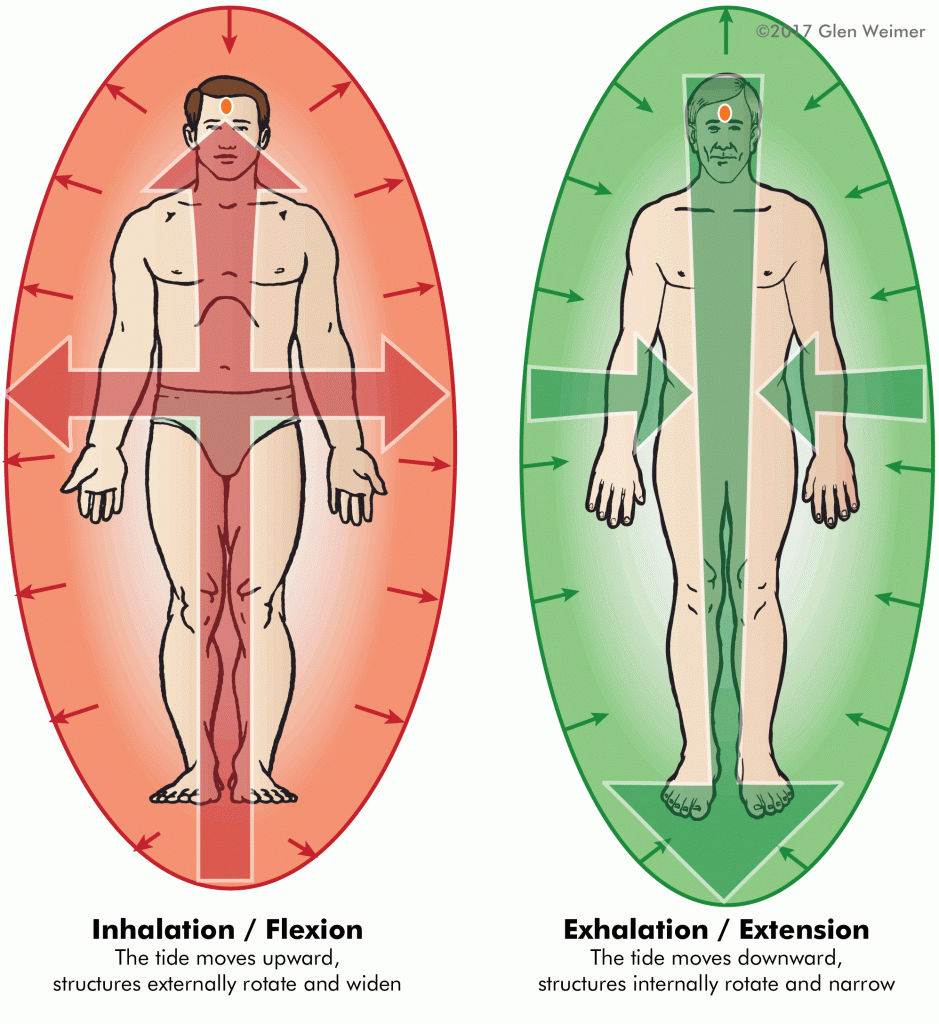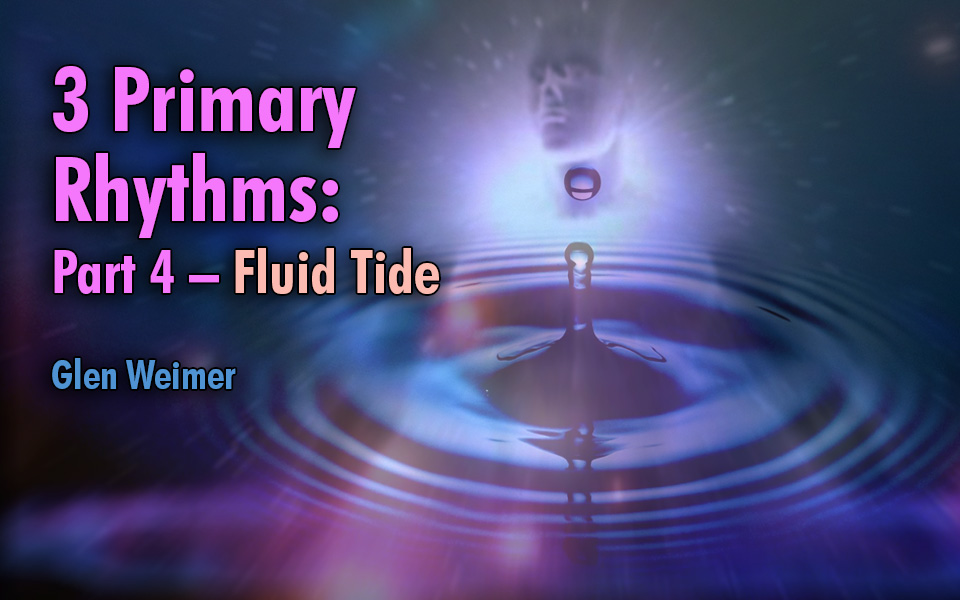Please note: this is the fourth installment of a 4-part blog. (see Parts 1, 2 & 3)
The Fluid Tide
The third rhythm I would like to discuss is the FLUID TIDE. This is the most subtle and difficult to describe but THE rhythm that is most critical for achieving lasting change in the body. The study of this rhythm comes out of Craniosacral Therapy. I use it in every session to help bring lasting change to the system.
Craniosacral Therapy is a gentle and subtle whole-body osteopathic approach that works with the core of our being: structurally, physiologically, emotionally, and spiritually. It influences the central nervous system; brain and spinal column, as well as the fluid that it bathes in. This fluid is called cerebral spinal fluid (CSF). The human body is 70+% fluid which moves in rhythm with the tidal motion of the CSF. This fluid motion underpins the shape and movement of every aspect of the body’s systems, from our musculoskeletal system and the bones of the cranium to each individual organ system.
Craniosacral therapists look beyond the heartbeat and thoracic respiration for another more subtle movement. We begin by sensing the presence of the ‘Whole’; all the body systems and their physical, physiological, and energetic movements as part of a single coordinated whole. There is a common misconception that craniosacral therapy only makes contact and works with the head. This tidal motion can be felt and addressed in every part of the body.
Fluctuation of the Tide
 So within this Whole we tune into the fluctuation of the Fluid-Tide which externally rotates, shortens, and widens all the structures of the body (head to foot); and internally rotates, lengthens, and narrows the structures. Dr. William Garner Sutherland (1873–1954), founder of Craniopathy, used to say “Every drop knows the Tide”. In part 1, I talked about the fluid motion of the Tide in embryological development shaping the body and its tissue movements (motilities). Through contortions in its flow, this tide also displays all the dysfunctional compensation patterns that the system has accumulated over time.
So within this Whole we tune into the fluctuation of the Fluid-Tide which externally rotates, shortens, and widens all the structures of the body (head to foot); and internally rotates, lengthens, and narrows the structures. Dr. William Garner Sutherland (1873–1954), founder of Craniopathy, used to say “Every drop knows the Tide”. In part 1, I talked about the fluid motion of the Tide in embryological development shaping the body and its tissue movements (motilities). Through contortions in its flow, this tide also displays all the dysfunctional compensation patterns that the system has accumulated over time.
Breath of Life
Here’s where it gets really strange and where biology meets quantum physics and metaphysics. As a cranial practitioner what we become aware of is a consciousness, within this fluid, what Dr. Sutherland called the ‘Breath of Life’. He says “Within that cerebrospinal fluid there is an invisible element that I refer to as the ‘Breath of Life’. I want you to visualize this Breath of Life as a fluid within the fluid, something that does not mix, something that has potency as the thing that makes it move. Is it really necessary to know what makes the fluid move? Visualize a potency, an intelligent potency, that is more intelligent than your own human mentality.”
So, when we engage with the craniosacral system it is not as a ‘fixer’, but instead, we bring our consciousness to participate with a super-conscious system enabling it to self-correct. It’s not an easy thing to put into words; it is less about doing, it’s like a dance where you are never quite sure who’s leading. We invite the system into a deep stillness where it can reorganize and free itself from these acquired dysfunctional movement patterns. Once the Tide reorganizes, the consciousness that creates and maintains our bodies has made a decision to change from the inside, so the structure and physiology follows. Those changes are lasting, affecting ALL the systems of the body because “Every drop knows the Tide”.
“You know from your experience as the patient that the Tide fluctuates;
it ebbs and flows, comes in and goes out, Iike the tide of the ocean.
You will have observed its potency and also its Intelligence, spelled with a capital ‘I’.
It is something that you can depend upon to do the work for you. In other words,
don’t try to drive the mechanism through any external force. Rely upon the Tide.”
~ Dr. William Garner Sutherland, DO
It takes specific training to tune into this system which we can’t do here, but what we can do is give you a sense of the rising and falling, internal and external rotations within the body. For that, I’m borrowing a basic movement technique from my friend Charmaine Lee. Her life work is called SysnergyDance.
FLUID TIDE EXPLORATION
This whole exercise should be effortless, fluid, and graceful. Imagine yourself submerged or floating in water. Play with all the subtleties of movement. If you are familiar with T’ai Chi, this will be similar.
Lie on the floor or carpet with your feet on the floor shoulder-width apart and knees bent, pointing upward. become conscious of your breath entering and exiting your body. Allow it to slow and soften.
Now allow your relaxed arms to float in the space above your chest. As you breathe in allow your knees to come closer together and your arms to glide up toward the space above your head. As you exhale allow your knees to fall apart and your arms to float down towards your pelvis. Repeat this motion with each breath—inhale, your knees move closer together, arms float towards your head; exhale, knees move apart and arms float towards the pelves. Take your time to really appreciate the subtle nuances and to deeply relax.
You may notice your feet pushing into the floor as you inhale and a wave-like motion rising through your body, rocking from pelvis to head as your spine elongates. And on the exhales, you might find that tidal wave rocking back down as your low-back curls and everything externally rotates. Are there also lateral movements? Does your head want to turn to one side or the other? What else are you observing?
To complete this exercise allow your body to integrate by bringing the soles of your feet together and allowing your knees to fall out to the sides, resting on (or near) the floor. (If this is uncomfortable you can lie flat or with a pillow under your knees). Bring all the fingers of each hand together into ‘a beak’. Allow the fingers of the left hand to come to rest on the 3rd eye (between the eyebrows) and the fingers of the right hand on the pubic bone (lower abdomen). Breathe, soften, and notice.
REMEMBER: ALWAYS LISTEN TO WHAT IS COMFORTABLE FOR YOUR BODY!
Disclaimer:
The information featured on this site is provided for information and education purposes only and is not intended to replace the advice of your doctor or health care provider on medical and/or health-related issues.
You should not use the information on this site for diagnosis or treatment of any health problem or as a substitute for medication or other treatment prescribed by your physician or health care provider.
Submit your review | |

